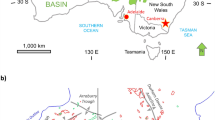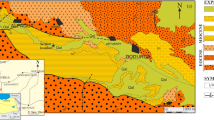Abstract
A suit of oil shales, predominated by black argillaceous silicalite and finely laminated black-brown shale, has been discovered in a set of carbonaceous-siliceous mudstone formations (350 m in thickness) in the third member of Xiamaling Formation of the Upper Proterozoic Qingbaikou Series (900-873 MaBP), Xiahuayuan, Hebei Province, China. The oil shale, combustible with strong bitumen odour, has super-high TOC contents ranging from 21.4% to 22.9%, bitumen “A” contents from 0.58% to 0.88% and oil length from 5.29% to 10.57%. The ultrathin section observation of the shale and the identification of its kerogen demonstrate that its hydrocarbon-generative parent material is mainly benthonic Rhodophyta whose specific tetrasporangia are legible and abundant. It is rarely reported in the literature that such a hydrocarbon-generative parent material, composed mainly of Rhodophyta and with extraordinarily high contents of TOC and bitumen “A”, developed into a set of high-quality source rocks. The extracts of the oil shale are characteristic of richness in 17α(H)-diahopanes and n-alkyl tricyclic terpenoids but low in steranes. Such a biomarker feature is obviously different from that of the extracts from other Proterozoic marine carbonate source rocks of the studied area. Since the biological constitution of this oil shale is rather simple, it is clear that these biomarkers most likely represent to certain extent the specific molecular constitutions of the benthonic Rhodophyta identified in the ultrathin sections of the samples. Studies on its lithologic association and depositional sequences suggest that this suit of the carbonaceous-siliceous mudstone formation, which contains oil shales, was probably developed in an undercompensation deep-bay environment when a maximum transgression occurred during the formation of the third member of Xiamaling Formation. The high concentration of SiO2 in this organic-rich rock and the positive correlation between TOC and some trace elements such as P, Cu, Ni, W and Mo indicate that this suit of rocks was affected by activities of bottom thermal currents as deposited.
Similar content being viewed by others
References
North F K. Petroleum Geology (Trans. by Gao Jiqing et al.). Beijing: Petroleum Industry Press, 1994. 95–102
Cook A C, Hutton A C, Shelrwood N R. Classification of oil shales. Bull Cent Rech Explor Prod Elf Aquitaine, 1981, 5: 353–381
Cook A C, Shelrwood N R. Classification of oil shales, coals and other organic-rich rocks. Org Geochem, 1991, 17: 211–222
Miknis F P, Smith J W. An NMR survey of United States oil shales. Org Geochem, 1984, 5(4): 193–201
Smith J W. Oil shale resources of the United States. Mineral and Energy Resources. Colorado: Colorado School of Mines Press, 1981, 23(6): 20
Carroll A R, Brassell S C, Graham, S A. Upper Permian lacustrine oil shales, Southern Jungar Basin, Northwest China. AAPG Bull, 1992, 76(12): 1874–1902
Wang D P, Liu L, Zhang L P, et al. Paleoclimate, sedimentary cycles and sequence strata of Songliao Basin (in Chinese). Changchun: Jilin University Press, 1995
Hao S S, Hydrocarbon prospect of the Middle and Upper Proterozoic in the northern area of North China. Oil Natural Gas Geol (in Chinese), 1984, 5(4): 342–348
Hao S S. Thermo-evolutional simulation experiment of carbonate source rocks. Acta Petrol Sin (in Chinese), 1987, (Suppl.): 25–31
Hao S S, Gao Y W. Petroleum Geology of the Middle and Upper Proterozoic in the Northern Area of North China (in Chinese). Dongying: Publishing House of University of Petroleum, 1990
Hua A X, Huang D F. Hydrocarbon Generation of the Middle-Upper Proterozoic organic matter and its biomarker characteristics. The Annual Report of Bio-and Gas-geochemistry Opening Lab., Lanzhou Institute of Geology, Academia Sinica (1988–1989) (in Chinese), 1989, 10–43
Liu B Q, Fang J. A preliminary discussion on the thermal evolutionary characteristics of the Middle-Upper Proterozoic and Cambrian organic matter and on the oil source in the Kuanchen area, northern Hebei. Petrol Geol Exp (in Chinese), 1989, 11(1): 2–8
Liu B Q, Qing J Z. An analysis on the characteristics of the Middle-Upper Proterozoic hydrocarbon source characteristics, oil seepage and oil source in Jibei Depression. Mar Pet Geol (in Chinese), 2000, 5(1–2): 35–45
Liu B Q, Liang D G, Fang J, et al., Organic matter maturity and oil/gas prospects in Middle-Upper Proterozoic and Lower Paleozoic carbonate rocks in northern China. Geochemistry, 1986, 5(1): 58–68
Wang T G, A newly-discovered tricyclic terpenoid biomarker series, In: Wang Tieguan et al. eds. Biomarker Geochemistry (in Chinese). Wuhan: China University of Geosciences Press, 1990. 5–11
Zhao C L, Li R F, Zhou J S, et al. Petroleum Geology and Sedimentology of the Middle and Upper Proterozoic in North China (in Chinese). Beijing: Geological Publishing House, 1997
Fang J, Liu B Q. An analysis on the hydrocarbon generative potential and its prospect of the Middle-Upper Proterozoic in the northern area of North China. Acta Petrol Sin (in Chinese), 2002, 23(4): 18–24
Zhang C G, Xong J H. A preliminary discussion on the hydrocarbon occurrence of the sub-Sinian in the western part of Yanshang Mountains. J East China Petrol College (in Chinese), 1979 (1): 88–102
Huang X H, Zhang Y W. Oil occurrence of the sub-Sinian and Lower Paleozoic in the western part of Yanshan Mountains. J East China Petrol College (in Chinese), 1979, (1): 103–114
Du R L, et al. Regional Geology of the Xiahuayuan Area and Guide to Field Teaching, 1986
Bian L Z, Zhang S C, Zhang B M, et al. Rhodophyte fossils discovered in the oil shale of the Xiamaling Formation in Xiahuayuan of the Zhangjiakou area, Hebei. Acta Micropalaeo Sin (in Chinese), 2005, 22(3): 209–216
Wang H Z, Shi X Y, Wang X L, et al. Studies on Sequence Strata in China (in Chinese). Guangzhou: Guangzhou Science & Technology Press, 2000
Zhang S C, Zhang B M, Bian L Z, et al. Discovery of rhodoids from the Xiamaling Formation of the Qinbaikou series of Xiahuayuan, Zhangjiakou of Hebei. Acta Micropalaeo Sin (in Chinese), 2005, 22(2): 121–126
Yan, T F. Collected Works on Organic Geochemistry (in Chinese). Lanzhou: Gansu Science & Technology Press, 1986
Mihkel K. Estonina oil shale. Oil Shale Extra, 1999, 1–22
Volkman, J K, Alexander R, Kagi R I, et al. A geochemical reconstruction of oil generation in the Barrow Sub-basin of Western Australia. Geochim Cosmochim Acta, 1983, 47: 2091–2106
Philp, R P, Gilbert, T D. Biomarker distributions in oils predominantly derived from terrigenous source material. In: Moldowan J M, Albrecht P, Philp R P, eds. Biological Markers in Sediments and Petroleum, Prentice Hall, Englewood Cliffs, N. J., 1986, 106–123
Zhang S C, Deng P, Peng Y, et al. Genesis of the Mesozoic-Cenozoic terrigenous oil in the Luntai upfaulted zone in Tarim Basin and its potential appraisal of source rocks. Xinjiang Petrol Geol (in Chinese), 1995, 16(4): 307–31
Zhao M J, Zhang S C. Significance of 17α(H)-diahopanes in the facies Indication of Tarim Basin. Petrol Explor Develop (in Chinese), 2001, 28(1): 36–38
Xiao Z Y, Tang Y Jn, Huo D J, et al. A study on the source of the Kekeya condensate reservoir. Acta Sediment Sin (in Chinese), 2002, 20(4): 716–720
Xiao Z Y, Huang G H, Lu Y H, et al. Diahopanoids in the Crude oil from Quele 1 Well and Its Source rocks. Petrol Explor Develop (in Chinese), 2004, 31(2): 35–37
Peters, K E, Moldowan, J M. The biomarker guide, interpreting molecular fossils in petroleum and ancient sediments. Prentice Hall, Englewood Cliffs, N. J., 1993, 160–164
Liu G Y. Oceanic Geography (in Chinese). Beijing: Beijing Normal University Press, 1989
Chen J F, Sun X L. A preliminary study on the geochemical characteristics and genesis of the organic-rich sections of the Neo-Proterozoic the Xiamaling Formation in North China. Nat Gas Geochem (in Chinese), 2004, 15(2): 110–114
Author information
Authors and Affiliations
Corresponding author
Additional information
Supported by the China State 973 Scientific Program Contribution (Grant No. G19990433)
Rights and permissions
About this article
Cite this article
Zhang, S., Zhang, B., Bian, L. et al. The Xiamaling oil shale generated through Rhodophyta over 800 Ma ago. SCI CHINA SER D 50, 527–535 (2007). https://doi.org/10.1007/s11430-007-0012-1
Received:
Accepted:
Issue Date:
DOI: https://doi.org/10.1007/s11430-007-0012-1




